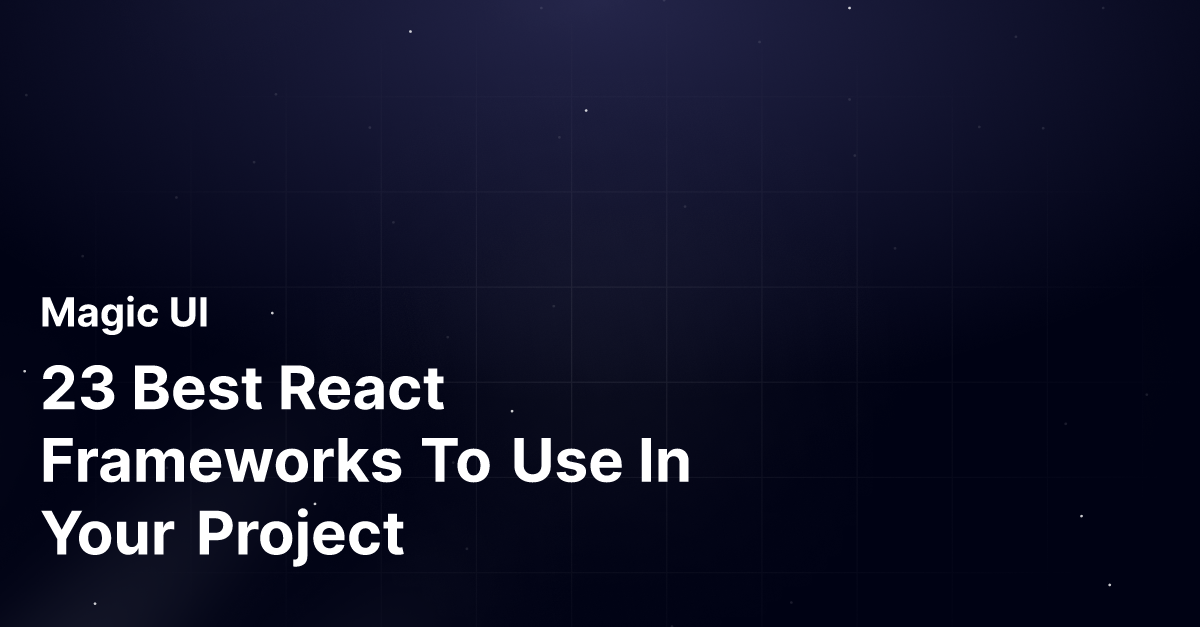Are you facing the challenge of choosing the right React component library among the myriad of UI Frameworks available? Feeling overwhelmed by the array of options and unsure of which one suits your project best? If so, you're not alone. Many developers encounter this common dilemma when it comes to React frameworks. This blog post will help you navigate this maze by providing valuable insights on various React component libraries. It will equip you with the knowledge to select a library perfectly tailored to your project's unique needs.
To ease your decision-making process and to help you achieve your goal of learning about the various React component libraries available and choosing a library best suited for your project, consider Magic UI's React component library. This tool will empower you with the necessary information to make an informed choice, sans any technical jargon, saving you time and ensuring your project's success.
What Is React?

React.Js is an open-source Javascript library developed by Meta for creating user interfaces (UIs). It helps create reusable UI components and uses virtual DOM to improve app performance. It can be used on both client and server sides and is easily integrated with other front-end frameworks. Its component-based approach, reusability, developer tools, and performance optimization make it a great choice for developers.
One of React's famous applications is Instagram. Features like geolocations, Google Maps APIs, and tags that pop up without hashtags are all impressive implementations of React. Even the makers of React, Facebook, use React for their webpage, and the mobile version is made using one of its famous frameworks, React native.
What Are React UI Frameworks?

React UI frameworks are libraries or collections of pre-built components that developers can use to quickly build user interfaces (UIs) for their React-based applications. These frameworks typically provide a wide range of pre-built components, such as buttons, forms, tables, and navigation menus. They also often provide design guidelines and a consistent look and feel to make it easier for developers to create visually pleasing UIs.
Related Reading
- What Are UI Components
- What Is A Component Library
- React Libraries
- React CSS Framework
- React Design Patterns
- Component Libraries
- React Best Practices
Major Features Of React

React promotes a component-based development approach allowing developers to break down the user interface into reusable components. This approach makes it easier for developers to manage and maintain complex UIs.
Encapsulation and Reusability
Each component can summarize its own logic and presentation, aligning development and promoting code reusability. The component-based architecture in React allows developers to encapsulate the functional, presentational, and logical components into reusable pieces that can be easily managed and combined to create complex UIs.
Simplicity in Creating Interactive Web Applications
Another advantage of the component-based architecture is that it offers a simple way to create interactive web applications. The component’s logic and presentation are contained within that isolated unit.
Enhanced Maintenance and Updates
React’s component-based structure makes it easier to maintain and update applications as developers can modify or patch individual components as required. As such, React enables developers to extend the functionality of their web applications by adding new components or modifying existing ones.
Scalability and Flexibility
The flexibility of the component-based architecture allows developers to modify the application’s functionality without affecting the rest of the codebase, which makes it easier to scale and maintain the application.
Promoting Code Reuse and Readability
The component-based architecture also promotes code reuse, as developers can reuse components across the codebase, saving time and effort. This structure allows web developers to build more readable, maintainable, and scalable applications.
Cost-Effective Modular Development
The component-based system of React helps developers to write modular and reusable code, which can be a cost-effective approach when developing multiple applications. This feature of React caters to enterprises that need scalable and robust web applications.
This approach to UI development can be particularly beneficial when building applications that require frequent updates or modifications. React's Component-Based Architecture makes developing complex user interfaces more manageable and efficient.
React Features: Virtual DOM
React uses a Virtual DOM (Document Object Model) to update the actual DOM efficiently. Instead of directly manipulating the DOM, React updates a virtual representation of it and calculates the most efficient way to apply changes. This approach results in faster rendering and a smoother user experience, as it minimizes unnecessary DOM manipulations.
Virtual DOM and React
React creates a virtual DOM tree in memory, replicating the actual DOM tree but is lightweight and faster to manipulate. When a component's state changes in React, the framework creates a new virtual DOM representation of the UI. React then calculates the difference between the previous and new virtual DOM trees, known as a diffing algorithm.
Optimizing DOM Manipulations in React
React identifies the optimal way to update the actual DOM based on the least number of manipulations required to render the change. By minimizing the number of manipulations, React ensures that only the necessary elements are updated on the actual DOM, which improves performance and creates a smoother user experience.
Efficiency with React's Virtual DOM
React’s Virtual DOM allows developers to optimize rendering on the browser by efficiently updating the actual DOM when the state of the application changes. The Virtual DOM feature of React contributes to its efficiency in rendering user interfaces.
Virtual DOM in React Performance
The Virtual DOM is a crucial part of React’s performance optimization strategy. By using a lightweight, in-memory representation of the DOM, React minimizes the number of updates needed when changes occur in the application, ensuring a smooth and responsive user experience. This feature makes React an attractive choice for building web applications that require dynamic and interactive user interfaces. React’s Virtual DOM is a key factor in its popularity among developers, contributing to the framework’s speed, efficiency, and overall performance.
React Features: Large Ecosystem
React has a vast and vibrant ecosystem of libraries, tools, and extensions. This ecosystem includes popular state management solutions like Redux, routing libraries, and various UI component libraries.
A Valuable Resource
React's popularity has led to a massive yet valuable source of resources and a supportive community. It ultimately makes it easier for developers to hop on effective solutions and answers to their web development challenges. The large ecosystem around React is a testament to its widespread adoption and versatility as a web development framework.
Extending React's Functionality with Libraries
React’s large ecosystem provides developers with a wide range of tools and libraries that extend the framework’s functionality and simplify development tasks. The vast ecosystem around React ensures developers have access to robust resources, making it easier to solve problems and build high-quality web applications.
Supportive Community and Resources in React
React’s ecosystem includes libraries and tools for everything from state management to routing, making it suitable for various projects. The large ecosystem around React also fosters a supportive community of developers who can share knowledge, resources, and best practices. This network of developers contributes to the framework’s longevity and popularity, making it a dependable choice for web development projects.
Diverse Solutions in React's Ecosystem
The large ecosystem around React includes libraries, tools, and extensions that extend the framework’s functionality and cater to various development needs. React’s popularity has led to creating a diverse range of resources and solutions that can help developers build robust, scalable, and high-performing web applications.
Tools for Efficient Web Development with React
The vast ecosystem around React ensures developers have access to the tools they need to create efficient and user-friendly web applications. The large ecosystem around React includes popular state management solutions like Redux, routing libraries, and various UI component libraries. These resources provide developers with the tools to create dynamic and engaging web applications.
Leveraging React's Ecosystem for Development
The large ecosystem around React contributes to the framework’s popularity and appeal among developers, making it a versatile and reliable choice for web development projects. By leveraging the ecosystem around React, developers can tap into a wealth of resources and expertise to help them build high-quality web applications efficiently. Ultimately, the large ecosystem around React simplifies web development tasks and makes it easier for developers to create scalable and performant web applications.
Empowering Design Engineers with MagicUI
MagicUI is a free and open-source UI library that we designed specifically for design engineers. It offers a collection of over 20 animated components built with React, TypeScript, Tailwind CSS, and Framer Motion. We provide a range of visually appealing and interactive elements that can be easily integrated into web applications, allowing us to create stunning user interfaces with minimal effort. MagicUI components are highly customizable, enabling seamless adaptation to match our desired branding and design requirements.
With a focus on animation and a design-centric approach, MagicUI aims to bridge the gap between design and development, empowering us to craft captivating digital experiences. Along with our free component library, with MagicUI Pro, you can save thousands of hours and create a beautiful landing page, and convert your visitors into customers with our website templates.
Use our React component library for free today at https://magicui.design/docs.
Related Reading
- Best React Native UI Library
- React Component Best Practices
- Tailwind Vs Bootstrap
- Material UI Alternatives
- Best React Component Library
- React Tips
- Create React Component Library
- Cool React Components
- Component Library Examples
- Bootstrap Vs React
- React Native Libraries
- Best React UI Framework
- Best React Native UI Library
- Next.JS
- Next JS
- React Bootstrap
- MUI Table
- MUI Card
- MUI Box
- What Is NextJS
Benefits Of Using A React Framework

Improved User Experience
React allows developers to build highly interactive and responsive user interfaces, resulting in a smoother and more engaging user experience. The virtual DOM efficiently updates and renders only the changed components, reducing load times and improving performance.
Reusable Components
React promotes a modular approach with reusable components, self-contained modules that can be used across different parts of an application. Reusable components save development time, improve maintainability, and make adding new features or fixing bugs easier.
Efficient Development Process
React provides a rich set of tools and libraries that facilitate the development process, such as React Developer Tools, Redux, and React Router. Its simple and intuitive syntax makes it easy to learn and use, especially for developers familiar with JavaScript.
Performance Optimization
React utilizes a virtual DOM and a diffing algorithm to efficiently update and render only the necessary parts of the UI, resulting in faster rendering and improved overall performance.
SEO Friendliness
React applications can be made SEO-friendly by rendering on the server-side and returning static HTML, which search engines can easily crawl and index.
Flexibility and Integration
React seamlessly integrates with other technologies and frameworks, making it a versatile choice for web development. It can be used with popular libraries like Axios for API requests or UI frameworks like Bootstrap for styling components.
23 Best React Frameworks To Use In Your Project

1. Magic UI
Magic UI is a free and open-source React component library designed for design engineers. It offers a collection of over 20 animated components built with React, TypeScript, Tailwind CSS, and Framer Motion. MagicUI provides visually appealing and interactive elements that can be easily integrated into web applications, allowing designers to create stunning user interfaces with minimal effort.
The highly customizable components enable seamless adaptation to match desired branding and design requirements. With a focus on animation and a design-centric approach, MagicUI aims to bridge the gap between design and development, empowering users to craft captivating digital experiences.
Features of Magic UI
- Highly customizable components that can adapt to desired branding and design requirements.
- Over 20 animated components built with React, TypeScript, Tailwind CSS, and Framer Motion.
- Visually appealing and interactive elements that can be easily integrated into web applications.
- Seamless animation and design-centric approach that bridges the gap between design and development.
- Free and open-source React component library designed specifically for design engineers.
2. Material UI
Material UI is a React component library that implements Google's Material Design. It provides a comprehensive collection of pre-built components ready for use in production right out of the box.
Features
- Pre-built components: A comprehensive collection of components, including buttons, forms, tables, charts, and more.
- Accessibility: A focus on accessibility, ensuring that all components meet the highest standards for usability.
- Customizability: A suite of customization options that make it easy to implement your own custom design system.
- Theme support: Support for theming, allowing you to change the look and feel of your entire application easily.
- Strong community: A large and active community of users and contributors.
3. Next.js
Next.js is a React.js framework developed by Vercel. It has unique features as compared to other frameworks like server-side rendering and enhanced search engine optimization. It provides a built-in routing feature giving it an edge over React. Prior knowledge of HTML, CS, JS and React is required before learning Next.js.
Features
- Hot Code Reloading: As soon as any changes are saved in your code, they will reflect in your user interface automatically.
- Server Rendering: The next.js rendering feature enables you to render react components to the server side first before sending it to the HTML client which helps enhance SEO.
- Automatic Routing: For any project the files in the page directory are automatically mapped and do not require additional coding for routing.
- Prefetching: The link component used to link various pages together supports prefetching of the resources in the background.
4. Ant Design
Ant Design is a React component library that implements Ant UMD, a design system for enterprise applications. It provides a comprehensive collection of pre-built components that are ready for use in production right out of the box.
Features
- Enterprise-level components: Ant Design provides a wide range of enterprise-level components, such as data tables, form layouts, and organization charts.
- Professional look: Ant Design's design system is more heavily influenced by Chinese design principles, resulting in a more elegant and professional look and feel.
- Out-of-the-box features: Ant Design offers several out-of-the-box features that are not available in Material UI, such as internationalization support and type safety.
- Customizability: Customizable options that simplify the implementation of your custom design system.
5. Semantic UI React
Semantic UI React is a React component library that implements the Semantic UI CSS framework. It provides a comprehensive collection of pre-built components ready for use in production right out-of-the-box.
Features
- Semantic HTML: Semantic UI React is built around semantic HTML, which means that the components are named and structured in a way that makes it easy to understand their purpose.
- Accessibility: Semantic UI React is committed to accessibility, and its components are designed to meet the Web Content Accessibility Guidelines (WCAG) standards.
- Theming: Semantic UI React provides built-in theming support, so you can easily customize the look and feel of your application.
- Extensibility: Semantic UI React is extensible, so you can easily create your custom components and themes.
6. MobX
MobX is a simple and scalable state management library for React applications. It provides a straightforward way to manage the application state, making keeping data in sync with the UI easier and ensuring smooth reactivity.
MobX is a versatile choice for developers who want to efficiently manage the state of their React applications, especially for projects with complex data flows and interactions.
Features
- Observable state
- Derived values
- Reactions
- Easy debugging
- Middleware support
7. Reass
Rebass is a React component library that simplifies building responsive and consistent user interfaces. Focusing on design procedure principles and minimalism, Rebass provides a set of highly customizable and themeable UI components. It's an excellent choice for easily creating aesthetically pleasing and user-friendly React applications.
Features
- Functional React UI components
- Theming support
- Minimalistic
- Extendable
- Highly composable
8. React Admin
React Admin is a framework developed for building admin interfaces and dashboards. It helps streamline the overall procedure of developing data-heavy applications, offering features like CRUD operations, and data handling.
React Admin is an invaluable tool for developers working on applications requiring robust data and user management functionalities.
Features
- Easy CRUD operations
- Pluggable architecture
- Data validation
- Internationalization
- Customizable UI
9. Material Tailwind - React
Material Tailwind is a popular design system and component library. Combined with React, this library becomes a powerful tool for creating stunning and responsive web applications.
This library seamlessly merges the Material Design aesthetic with the utility-first approach of Tailwind CSS. It provides a wide array of pre-designed components, UI elements, and styles that help developers build modern and visually appealing interfaces with ease. Material Tailwind for React is a practical addition to the toolkit of developers who aim to deliver user-friendly and aesthetically pleasing web applications while leveraging the efficiency of the Tailwind CSS utility classes.
Features
- Tailwind CSS with Material Design
- Prebuilt components
- Easy customization
- Responsiveness built-in
- Dark mode support
10. Grommet
Grommet is another React UI component library known for its accessibility and simplicity. It provides a set of ready-to-use components designed to focus on responsiveness and accessibility. This Grommet library has distinguished itself for Javascript developers who prioritize creating user-friendly web applications that adhere to accessibility standards.
Features
- Accessibility-first components
- Themable
- Responsive design
- Dark mode
- Server-side rendering
11. Material Kit React
When discussing the best UI framework for React, one cannot overlook Material Kit. Inspired by Google’s Material Design, Material Kit builds a group of elements that make consistency the primary feature. This feature lets you maintain a similar appearance and functions throughout your project. The layout is like multiple sheets of paper, giving it depth and order.
Features
- Grants access to the theme values from the component props
- Open source, extremely fast, and high-quality
- Less than KB gzipped
- Developer-first product with a solid community
- Supports several variables
- Good UI consistency with an effortless and responsive layout
- Follows code standards
- MIT license
12. Storybook
Another special mention on our React JS framework list is Storybook. Storybook has been popular among developers for a long time now. It is not a component library itself. It is more like an open-source tool for building UI components in isolation for React and several other platforms and technologies.
What’s unique about Storybook? It enables you to work on a single component at a given time, making the development process much faster.
Features
- Fast UI development
- Easy and smooth integration with React apps
- Comes with builtin TypeScript support
- Default webpack configuration
- Efficient development process
- High compatibility with most front-end frameworks
- CSS support
- Hot module reloading
- Deployment of a whole storybook as a static app
- Isolated environment for components
- Clean and efficient UI
13. React Bootstrap
Next on the list of best React UI frameworks is React Bootstrap, one of the oldest React UI libraries. If you are looking for a front-end React UI framework, you can definitely pick React Bootstrap.
This UI kit holds on to its Bootstrap core but switches Bootstrap’s JavaScript with React. This switch gives you more control over the function as well as the form of every component. Every component is accessible, important for building front-end frameworks.
Features
- Supports NPM and SAAS
- Used as Prop API
- Offers CSS Support
14. Blueprint
Blueprint is a React-based UI toolkit that includes meticulously designed components for building elegant and responsive web applications. This toolkit focuses on simplicity, functionality, and a united design language.
Blueprint's components cover a wide range of UI elements, from buttons and forms to data visualizations, ultimately making it a valuable resource for developers aiming to create polished and professional web applications.
Features
- Designed for desktop
- Customizable
- Rich component library
- Theming
- TypeScript support
15. Gatsby
Gatsby is a UI framework for React used to create static web applications. It is built on top of React.js and Node.js, so knowledge of HTML, CSS, React, and Node is required. Gatsby helps develop fast-loading and high-performance static web applications that can render data from multiple sources. It has a great data plugin ecosystem and allows users to fetch data directly into a Gatsby application using GraphQL.
Features
- Fast Load
- Automatic Routing
- Data Combining from various data sources
- Higher performance by code splitting, inlining critical assets and smart preloading.
16. React DnD
React DnD, short for React Drag-and-Drop, is a powerful library for adding drag-and-drop functionality to React applications.
React applications that involve reordering items, managing file uploads, or creating interactive user interfaces - find this library very helpful in simplifying the complexity of drag-and-drop interactions. React DnD offers both flexibility and ease of use in managing drag-and-drop operations.
Features
- Drag-and-drop
- Extensible backends
- Flexible rendering
- Multi-backend support
- Debugging utilities
17. Styled Components
Styled Components is another library that allows developers to write CSS within their JavaScript components. It promotes component-level styling, improving code maintainability and reducing the risk of styling conflicts.
With Styled Components, the developer can create dynamic and responsive designs while keeping the styles organized within the React components.
Features
- Dynamic styling
- Theming support
- Server-side rendering
- CSS-in-JS
- Native support
18. React Fabric
React Fabric is a set of responsive and accessible UI components for building web applications. Developed by Microsoft, it adheres to the Fluent Design System, ensuring a consistent and visually appealing user experience.
React Fabric components are specifically designed to work well with various web platforms and browsers, making them a solid choice for creating web applications with a polished and modern look.
Features
- Office UI components
- Accessibility support
- TypeScript support
- Regular updates
19. React Toolbox
React Toolbox is a React UI components library. This library can implement Google’s Material Design principles in projects. React Toolbox uses CSS modules for this implementation. Although you can utilize any module bundler, React Toolbox integrates seamlessly with Webpack workflow. Moreover, the React Toolbox team provides an in-browser editor where developers can play with components in real time.
Features
- Supports responsive design
- High-quality and well-tested components
- Modular architecture
- Provides a set of components that are pre-built and customizable
20. React Router
React Router is a popular compact library for React. It allows developers to build single-page applications with dynamic, client-side routing. React Router is designed to work seamlessly with React, and it allows developers to declaratively define the routes of their applications using JSX. This makes creating complex and hierarchical navigational structures within a single-page application easy.
Features
- Uses windowing to render a small portion of a large data set
- Provides flexible API
- Supports responsive design
- Virtualization allows it to only render elements that are on the screen
21. Chakra UI
Next on our React JS framework list is Chakra, a React component library that requires less time to write code. The Chakra UI enables faster development and offers accessible, modular, and flexible UI components for building applications.
Chakra UI enables React developers to create newer components efficiently. Chakra UI's components are customizable, reusable, and adhere to the WAI-ARIA standards.
Features
- Offers accessibility for users with disabilities
- A comprehensive set of reusable components
- Light / Dark mode support
- Uses CSS-in-JS
22. React Virtualized
It’s time to get introduced to one of the most powerful React libraries! React Virtualized renders the large lists and tabular data in React applications. It employs techniques like windowing and virtualization to optimize performance when dealing with extensive data sets.
The React Virtualized library is especially valuable for developers working on projects that display extensive tables or lists, where rendering efficiency is critical.
Features
- Large lists and tabular data
- Performance optimizations
- Windowing
- Flexible styles
- Scroll syncing
23. React-Motion
React-Motion is a library for creating smooth and interactive animations in React applications. It offers physics-based animations enabling developers to bring life to their web interfaces.
With React-Motion, you can achieve fluid, interactive animations that enhance the user experience, making it a valuable tool for projects that require engaging visual effects.
Features
- Spring-based animations
- Configurable
- Interpolations
- Optimized performance
- Animation stacking
How To Choose A React Library For Your Project

When choosing a React framework, evaluating the project's needs thoroughly is essential. Consider the components and features required for your specific project. Large-scale projects may need a more comprehensive library with a wide range of components, whereas smaller projects may not require as many features. It is crucial to consider the scale and type of your project when selecting a React component framework. Consider any specific requirements that your project may have. For instance, if your project heavily relies on data visualization, you may need a framework that provides robust chart components.
Longevity
Selecting a React framework with a good track record of active maintenance and regular updates is crucial for the longevity of your project. Choosing a frequently updated library ensures that you will not have to migrate to a new library in the future. It also means you are more likely to receive ongoing support and bug fixes for the library. By selecting a React library that is continually updated, you can rest assured that your project will remain up-to-date and secure.
Learning Curve
Considering the learning curve of a React framework is crucial, particularly for teams with varying levels of experience. Opt for a library with an intuitive, user-friendly interface and easy-to-understand documentation. A library with well-structured and clear documentation makes it simpler for new developers to learn and use the library efficiently. It also helps developers quickly familiarize themselves with the library's features and components, speeding up the development process.
Customizability
When choosing a React framework, customizability is a significant factor to consider. Select a library that allows for easy customization to ensure that it can align with your brand's design guidelines. Some React libraries offer more extensive customization options than others, so choosing a library that meets your specific design requirements is essential. Customizability enables you to adapt the library to fit the unique design needs of your project, creating a more cohesive user experience.
Add Magic UI
All React libraries are slightly different and have unique offerings. To maximize the benefits of using any React component framework, you need to add Magic UI. Magic UI complements the effectiveness of your chosen React framework by providing additional features and components that enhance the user experience. By incorporating Magic UI into your project, you can take advantage of additional functionalities that may not be available in your primary React library. This integration helps you create more dynamic and visually appealing user interfaces that align with your project's design and functionality requirements.
Check Out Our React Component Library for Design Engineers
MagicUI is a free and open-source UI library that we designed specifically for design engineers. It offers a collection of over 20 animated components built with React, TypeScript, Tailwind CSS, and Framer Motion. We provide a range of visually appealing and interactive elements that can be easily integrated into web applications, allowing us to create stunning user interfaces with minimal effort. MagicUI components are highly customizable, enabling seamless adaptation to match our desired branding and design requirements.
With a focus on animation and a design-centric approach, MagicUI aims to bridge the gap between design and development, empowering us to craft captivating digital experiences. Along with our free component library, with MagicUI Pro, you can save thousands of hours and create a beautiful landing page, and convert your visitors into customers with our website templates.
Use our React component library for free today at https://magicui.design/docs.
